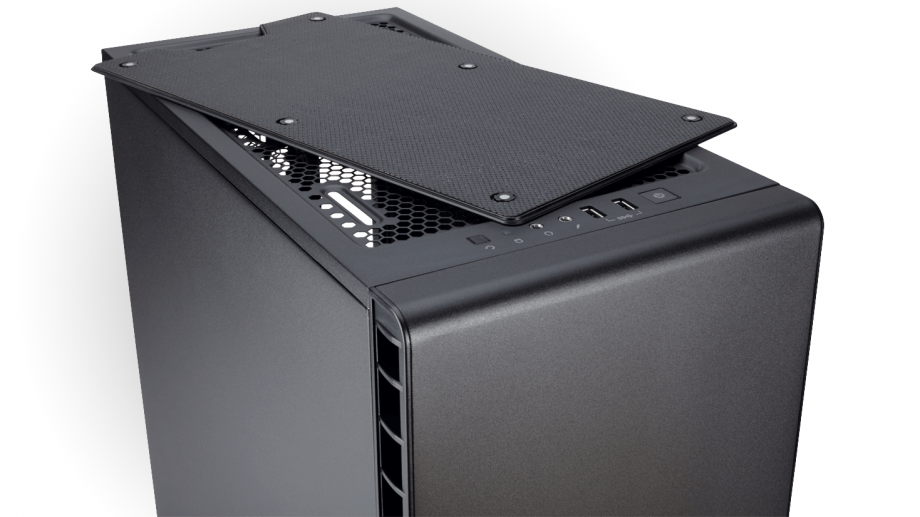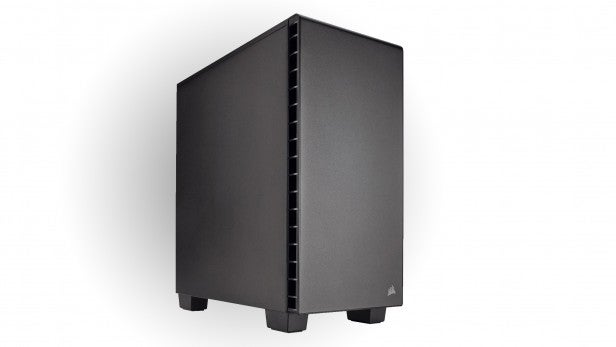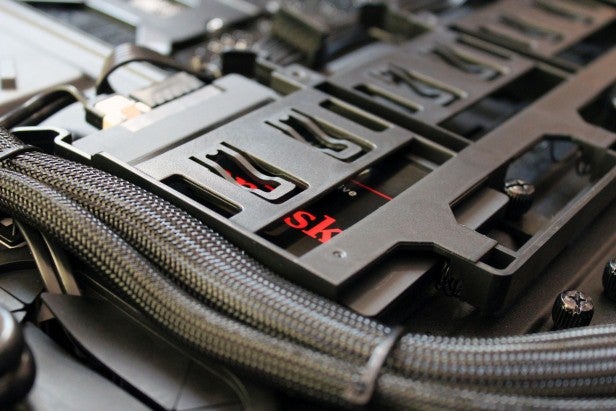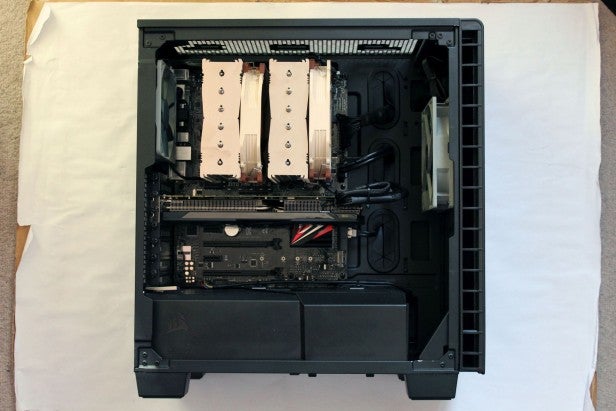Scan 3XS Z170 Vengeance Q Review
Scan 3XS Z170 Vengeance Q
This high-end gaming PC is packed with components designed for super-quiet operation

Sections
- Page 1 Scan 3XS Z170 Vengeance Q Review
- Page 2 Performance and Verdict Review
Verdict
Pros
- Easily plays 1440p games
- Near-silent in most tests
- Sleek, smart design
Cons
- Processor isn’t an unlocked model
- Mediocre SSD speeds
- Some upgrades tricky to use
Key Specifications
- Review Price: £1500.00
- 4.09GHz Intel Core i7-6700 processor
- Nvidia GeForce GTX 980 4GB
- 16GB 3,000MHz DDR4 memory
- 960GB SanDisk SSD
- Windows 10 64-bit
- 3yr warranty
- Manufacturer: Scan
What is the Scan 3XS Z170 Vengeance Q?
Gaming systems with high-end hardware such as GTX 980 graphics cards and Core i7 processors follow a familiar blueprint. They’re always fast, but they’re usually noisy, with fans that produce a racket that only speakers or a headset will eliminate.
Step forward the 3XS Z170 Vengeance Q. Scan has tested three power supplies, a trio of heatsinks and four different case-fan combinations to build a gaming system that’s full of high-end components that barely make a whisper.
Related: Our Top Picks for Oculus Rift
Scan 3XS Z170 Vengeance Q – Design, Build Quality and Connectivity
The sheer number of components tested by Scan demonstrate the firm’s meticulous approach when putting together this system. Those heatsink experiments led the firm to the Noctua NH-D15, which is designed for low-noise operation. Heat from the processor is distributed by six thick pipes across two huge heatsinks – rather than one on a normal cooler. In addition, it uses two 140mm fans that move air through the case while spinning more slowly than the single 120mm fans on conventional products.
This isn’t the only area where Scan has decided that Noctua hardware is best. The company has replaced the default case fans of the Corsair chassis with slower, quieter Noctua models – a 140mm input and a 120mm exhaust model. 
The firm concluded that the Corsair RM650x was the best power supply for one key reason: if the system isn’t drawing more than 260W, its fan won’t spin. That’s another clever touch designed to tone down the noise.
Opting for the Corsair Carbide 400Q case is also down to its low-noise features. Its side panels are coated with a material that’s designed to absorb sound waves, and the PSU is hidden behind a shroud. Dust filters cover every air intake to prevent the internals becoming clogged up, and the top panel is attached with magnets rather than screws, which can sometimes rattle.
The Vengeance Q’s noise-reduction features are paired with understated looks. The Carbide is built from big black slabs of steel, with no side window and a front section that displays only a modest Corsair logo.
The Carbide impresses in more conventional areas, too. Its drive bays are all tool-free, and build quality is consistently solid. Scan has done an excellent job of building too – cables are worked in straight lines and are stuck to the interior surfaces with cable-ties and pads, so there’s no chance of wires getting in the way.
My only concern is upgrade room, which is inconsistent. There are only a couple of free drive bays, and there are pairs of PCI Express x16 and x1 slots empty on the motherboard – but several upgrade paths are blocked by the size of the components. The chunky graphics card makes it difficult to access empty SATA sockets, and the two free memory slots are entirely hidden by the huge heatsink. Most upgrades will require some degree of dismantling.
Still, the Vengeance Q stacks up well in this department against the PC Specialist Ignis, which had a single 2.5-inch bay free and no other realistic upgrade paths.
The Scan has more room and is sturdier than the PC Specialist’s acrylic Parvum chassis, but it’s also bigger. The Corsair Carbide case is 464mm tall – modest for a tower, but the PC Specialist was just 244mm from top to bottom.

Related: Best Gaming Laptops 2016
Scan 3XS Z170 Vengeance Q – Specifications
Many of the case features have been picked for low-noise operation, and most of the components have been through the same process.
The most intriguing is the processor. Scan has eschewed the more familiar unlocked silicon for a standard Core i7-6700. That’s one of Intel’s more modest high-end chips: it has four Hyper-Threaded cores, but the base clock speed of 3.4GHz is underwhelming.
The lack of unlocking means there’s little chance to do serious overclocking. Instead, Scan has only been able to tweak the base clock to 102.25MHz, which means that the i7-6700 hits a Turbo Boost peak of 4.09GHz rather than a straight 4GHz.
While this doesn’t sound too good, there’s a good reason behind this being Scan’s chip of choice: its power requirement of 65W is far lower than the 91W required by the Core i5-6600K used in PC Specialist’s system. The Scan’s CPU might seem modest on paper, but that lower power requirement means it generates much less heat – which means the Noctua cooler and its slow fans generate barely any noise.
That train of thought follows through to the graphics card. The GTX 980 is a high-end chip that’s had its base speed of 1,026MHz overclocked to 1,126MHz, but despite that it’s built for low noise operations. Manufacturer EVGA has equipped the GTX 980’s hefty heatsink with a low-power motor, optimised fans and double ball bearings.
Scan has fitted this machine with a 960GB SSD in order to avoid installing a hard disk – so that’s another potentially noisy component eliminated. There’s also 16GB of DDR4 memory that rattles along at 3,000MHz.
Everything connects to an Asus Z170 Pro Gaming motherboard. It’s a mid-range PCB with modest looks – there’s no sign of big, snazzy heatsinks here – but that’s not a problem when this PC doesn’t come with a side window. 
It’s a conventional board. It features plenty of free slots and sockets, and has audio and networking circuits that can prioritise gaming traffic. The inclusion of a free M.2 socket is ideal for super-fast PCI-based storage. On the rear there are four USB 3 ports, USB 3.1 Type-A and Type-C connectors and five audio jacks. The Asus board ticks every practical box, although it’s missing enthusiast features such as on-board buttons and displays.
There remain areas where the Vengeance Q’s specification crosses over with the PC Specialist Ignis, however. Both systems share GTX 980 graphics, and both also have 16GB of memory and 960GB SSDs.
PC Specialist’s machine had a mini-ITX motherboard that has less upgrade room but more high-end features than the Scan’s Asus board. The application benchmarks will also make for interesting reading: the Ignis has a stock-speed Core i5-6600K processor.
Scan keeps its machines clean when it comes to software. The only app installed is a small tool lurking in the taskbar that provides links to component testing tools and tech support.
Far more is included on a 16GB USB stick that Scan attaches to the inside of the case with a patch of velcro. It’s a great idea: it means Windows is kept free of apps while Scan can still provide its customers with support applications, a Windows 10 recovery image and a gallery of benchmark scores attained by Scan during testing.
Related: The Games to Watch in 2016


